#madscarypodcast
Explore tagged Tumblr posts
Text
Episode 1 Recap: The Color Under the Shadow of Space
Welcome back! It's our first official episode.
If you listened to our intro episode and/or read the blog you know that we’re officially kicking off our research with AI-generated recommendation Under the Shadow (2016). After we wrapped recording, I decided to throw my pick The Color Out of Space (2020) for a solid - something comes into my house and ruins the vibes - double bill. Hey look! It's us.


Before we get into that, we start off by chatting about our fancy photo shoot with photographer of Terrifier 2 fame and friend of the pod, Jeff Harris Studios. Thank you, Jeff! Dropped a few favorites below. Spooky stuff.
We’re super excited to have him on in a few episodes to discuss shooting on horror film sets and some of his favorite scary movie tropes. Cannibal stuff is mad scary and mad gross, yo. I insist on digging in on Armie Hammer’s disturbing proclivities. After a viewing of House of Hammer, I’m left speechless on what I’ve seen & heard but excited to share my vengeance-filled lucid dreams. Also richies probably eat people all the time, right?
Rina then shares an update on OpenAI’s legal hot water. ChatGPT be hallucinating too much and OpenAI is going to need to evaluate their loosey goosey legal language. Finally, we share shark attack stories since Jaws was back in theaters 4th of July weekend. Also, are there lake sharks? I don’t want to know.
We then dig into Babak Anvari’s Under the Shadow (2016) but Rina is unfortunately reminded of another Babak Anvari movie, Wounds (2019). She did not care for it. Guess who’s in it? Armie Hammer. Womp, womp. He was definitely part of the problem but Rina's not keen on the execution overall.
Anywho, we do a pretty solid recap of the movie - it’s 1988, Tehran and we’re introduced to a family navigating life during a war as well as mysterious and supernatural happenings in their home. Rina does a great job laying out the lore of the Djinn and chat some of the tropes - creepy little kids, Moms being suss, and real-life terror juxtaposed with supernatural terror. We discuss some of the creative choices that really stood out to us; like the fact there was little to no music and the washed out, bright overexposed photograph look of the movie. We talk about our favorite scenes - a solid jump scare, a creepy foot through a ceiling crack, and an open-ended non-ending. All in all a fantastic movie. Mad Scary not Mad Corns. Significantly better than Wounds. This was definitely Babak’s story to tell.
We keep it going and chat through Richard Stanley’s The Color Out of Space (2019) based on the H.P. Lovecraft story of the same name. Jesus Christ. This movie. We talk high-level about the plot. You have five to ten minutes of exposition and an introduction to the Gardner family - they live in the country, they have llamas which may or may not be a poor investment, the daughter is a Wiccan, her brother is into smoking weed and space stuff, their little brother wears glasses and has a lisp.
Things immediately start going crazy after a meteorite crashes onto the Gardner’s land. The level and pace in which this movie escalates can only be likened to a freight train speeding into a fever dream. It’s also mad gross. This is Richard Stanley’s second mainstream movie. His first was the ill-fated Island of Dr. Moreau (1996). It was so bad they made a documentary about it. Anywho, this man clearly likes gooey gross because he leans in hard. The body horror and gore is off the chain. My man also has an unsavory past with women - can we separate the art from the artist? I'm having a time with it.
Wait!? Did I mention Nick Cage plays Papa Gardner? I didn’t!? My bad. Um, Nicholas Cage plays the dad in this movie and I just love him for it. If I ever get to meet him, I need to ask him about some of his choices - all inspired but I just want to know why he made them cuz we got theories. Mr. Cage, what's up with that voice? Nick Cage's performance, the saturated colors, and the narrative device make this movie a must watch. Mad Scary approved.
We’ve collected some tropes from both movies. While Rina felt they weren’t super similar, I think the tropes speak volumes. Horror movies that take place in the home feel the scariest because our homes are where we are meant to feel safe, comfortable, and the most ourselves. The idea of something coming into that safe space and terrorizing you, and you have nowhere to go to escape it, is mad scary.
Common Horror Movie / Scary Tropes & Devices
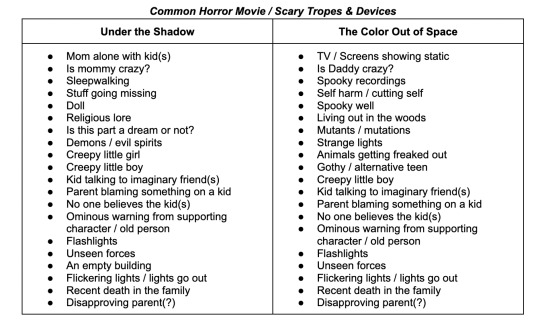
Here are the interviews that I promised: Babak Anvari Interview Richard Stanley Interview
For Episode 2, we decided on Alex Garland’s Ex Machina (2015), a movie we were planning to watch together pre-podcast. It’s one of Rina’s favorites and feels very fitting in terms of our AI co-collaborator. Finally, we asked Chat GPT to recommend a good companion film for Ex Machina. Here’s how it went:
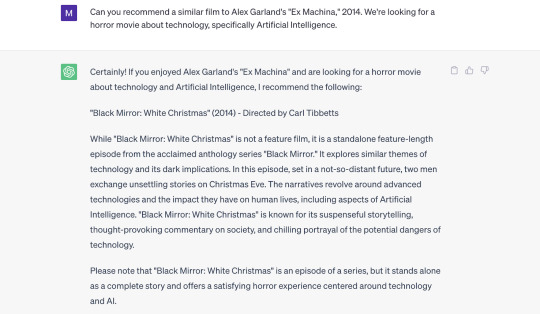
In classic ChatGPT form, it beefed the request and recommended an episode of Black Mirror. No. That’s not a movie. We try again:
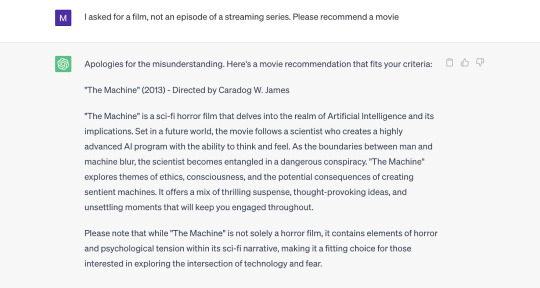
Ok! We’ll be watching Ex Machina & The Machine next episode. We’ll also start to talk about our writing process and make some plans/next steps around writing our script. I’ll also try to limit the amount of times I say the word fascinating. See you in a few weeks!
#generativeai#horrormoviepodcast#artificial intelligence#movies#nicolas cage#writing#madscarypod#madscary#madscarypodcast
2 notes
·
View notes
Text
Text-to-Image Ai Update

Prompt: "line drawing of ghostly hands typing on a computer keyboard, writing a blog post." (Generated Feb 2024; Dall-E)
When we began this research project last summer, we wanted to try out any publicly available (and usually free) AI tools to help us with the various aspects of conducting an experiment, producing a podcast, and writing a horror screenplay. One we ended up using often are text-to-image tools to create cover images for our episodes, social media posts, and more.
Our first use case - as you'll remember from one of our first blog posts - was to create our Mad Scary Podcast logo and image. Some takeaways there was that text-to-image tools (at that time, ~9 months ago) struggled with generating human features (like hands and faces), symbols (words, letters, numbers - even crucifixes on gravestones), and contextualizing certain figurative descriptors (like "eerie" or"spooky"). While some of the results were interesting or to our liking, we were new at writing prompts (specifically prompts for image generations vs text generation) and didn't actually have a clear idea of what we wanted.

Prompt: "full moon at night over new york city, spooky, in the style of a graphic novel." (Generated Jun 2023; Canva Magic Studio)
Eight months later, we're still struggling with some of the same things, but have learned (surprisingly) that less is more. Giving ChatGPT or Dall-E a more detailed prompt, rife with notes on style or tone may work sometimes, but I've noticed that they often ignore details that appear later in the prompt text. I suspect this is because the later details may "contradict" the earlier ones, or may seem redundant. For example, if you included "realistic lighting" and then "high contrast" later in the prompt - perhaps the LLM disregards the second lighting cue since it already has one? Or, maybe it's more simple than that; it doesn't understand what the ask is, or the punctuation used might be off.
Below are 2 images produced (this month, March 2024) from the same prompt, generated in Canva Magic Studio (available with a Canva pro subscription):


The prompt for both was the following: "2 ghost girls, sitting at a desk writing on paper or typing on a computer; one girl has long brown hair, one girl has medium length black hair; ambient lighting, realistic lighting."
The only difference I introduced was selecting from the list of possible themes available -- sort of like IG or Snapchat "filters." I chose the "Dreamy" theme for the image on the left, and "Oil Painting" theme for the one on the right. Though both are interesting to me, the image on the right seems to incorporate more of my prompt cues than the left (differences in hair color, both writing tools). Another interesting thing is that it ignores the "ghost" element, while the left image goes hard on it. It also makes me wonder if the data sets it pulls from for the "Oil Painting" theme includes more variety in terms of skin and hair color, objects (different iterations of a desk), maybe even race? If we were to reduce it down to the "idea" of a girl, or a ghost, or a desk -- like Plato's forms -- is there more/less variability for the output for one theme/style over another? Some questions to keep in mind in our continued experimentation with these tools, for sure!
0 notes
Text
Bonus Ep Recap: Spooky Season
Hello all. Rina and I share our picks for Spooky Season. These are not in rank order, ya'll.
Millie’s List The Stuff (1985) written and directed by Larry Cohen This movie is chock full of super fun satire. Way ahead of its time - it digs into the stronghold of viral marketing; our obsession with food and our want to fill the void w/a sweet treat, corporations selling their souls to make a buck. Well done Mr. Cohen. Also, if you have Michael Moriarity in your movie it’s gonna be a banger. 1 million corns up. Elvira Mistress of the Dark (1988) Directed by James Signorelli Written by Cassandra Peterson (Elvira, herself), John Paragon, and Sam Egan This movie is right up there with Beetlejuice for me but doesn’t get the same love. It has a lot of the same funny scary energy. Some really great jump scares, gooey monsters, and family drama. Not to mention Elvira is iconic - strong, beautiful and hilarious with some classic ditz. Gotta love her. Also 1 million corns up. Buffy the Vampire Slayer (1992) Directed by Fran Rubel Kuzui Written by Joss Whedon This movie was life changing. Not only was it all the spooky things I love but I was introduced to one of the greatest female superheroes ever. I love the show but this movie has a special place in my heart. I love the early 90’s campiness of it. The love and reverence paid to the valley girl archetype and there’s some really classic Paul Ruebens post-Pee Wee that’s just the best. Rautger Hauer is both menacing and hilarious. All the corns. Babadook (2014); written and directed by Jennifer Kent Ok, like legit I haven’t been this scared since The Ring. I couldn’t sleep for days/maybe weeks after this movie. If you’re afraid of the dark - which I am - this is going to hit you like nothing else. Also, it’s also a “real” movie w/proper themes. It’s a wonderful play on the parent child relationship, especially parents w/neurodiverse kiddos. Amazing. All the corns, as well. The Color out of Space (2019); story by HG Wells directed by Richard Stanley You’ve already heard me talk about my love of this movie. It’s just great. Really gross. Really irreverent. Very scary. It has a lot to say and I’m here for it. You can never go wrong with a Nicholas Cage film. He sells the whole thing. All the corns facing up.
Rina’s List I was initially thinking of the quintessential fall horror movies that remind you of Halloween and the harvest and things like that. For that vibe, my list looked like this: Halloween, Sleepy Hollow, Pumpkinhead, Children of the Corn, Wicker Man. The Pale Blue Eye (2022) would be an honorable mention here (but ultimately a letdown). But I didn’t really feel like my heart was in that list. Although I fucking love Sleepy Hollow, and I definitely watched the Pumpkinhead series too much as a kid (shoutout to it ALWAYS being on on SciFi channel), what I really like to watch when the leaves start to turn and the days start to get shorter are movies that have a classic spooky vibe. What I mean by that is like movies that are foggy, and the character is basically alone. Maybe there’s a cool old creaky mansion (no longer in its prime/spendor), or a remote cabin. There are definitely scenes of the protagonist walking through a crunchy yard, or sparse, foggy woods.
With that in mind, here's my list of (fairly recent?) movie recs for the remainder of the Spooky Szn, in no particular order: The Witch (2015) - Robert Eggers’ full-length writer/directorial debut (sticking to our writer/director theme accidentally?) Also known as the V-Vitch. Maybe the ultimate harvest season, New England, spooky tale? It’s got it all: the unforgiving, remote wilderness; crops failing mysteriously; heavy religious overtones; creepy (and annoying) twins; virginal teen daughter; “is mommy crazy?”; goat. “Similar but different” bonus pick: Stoker (2013); also coming-of-age, teen girl story? The Awakening (2011) This movie is moody as hell! Fog; beautiful manicured grounds; cronchy piles of leaves; spooky boarding school; hollywood hunk Dominic West taking a bath; creepy lil kids; ominous warning from an old lady character; ghost hunting! “Similar but different” bonus pick: The Others (2001); also a story about a woman with a husband who went to (a different) war and wants to protect children? Don’t Be Afraid of the Dark (2010) I like this version over the 1973 original – it's a whole different vibe. This one is more, “parents not listening to the kid,” and the original is more, “is mommy crazy?” This one is set at a beautiful, old, Rhode Island mansion. Spooky groundskeeper; precocious little girl; new stepmom vying for approval; preoccupied dad; things going missing; things going bump in the night. “Similar but different” bonus pick: Silent House (2011); also a story where a woman is fixing up an old house to sell it? Deerskin (2019) Guy buys a deerskin jacket and goes off the rails. It was way too much money and he threw in a camcorder. “Similar but different” bonus pick: Creep Crimson Peak (2015) Gorgeous movie, saturated with color. The costumes, the house, the mysterious family secret. A little bit more of a late autumn/early winter movie but it fits the mood.“Similar but different” bonus picks: The Haunting (controversial hot/bad take: I prefer the 1999 over the 1963); also a movie set at a beautiful, haunted house with a dark and dangerous past?
Honorable mention: Not a Movie → The Haunting of Hill House Dishonorable mention: Sucked and was bad → The Lodge We asked ChatGPT to participate, as well. Here's what it said:
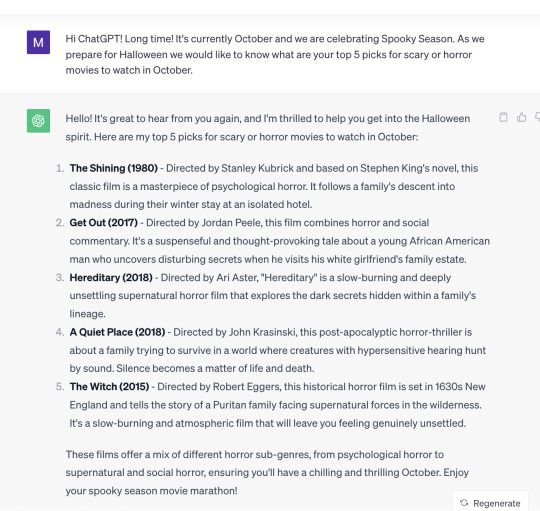
Then we were like - hit us w/a bonus.
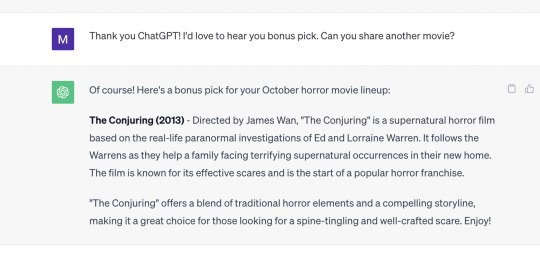
Nailed it. Honestly, these are all just good. For any season. So, happy watching!
Have a rec? Add it up in our comments.
0 notes
Text
Using Generative AI to come up with a Podcast Name
In a previous post, I talked about how we used Generative AI tools to create a logo we liked. All that remained to get our podcast started was a good name and spooky theme music.
For ideas, we turned to OpenAI’s ChatGPT, which has accumulated over 100 million users* in the past few months and has a free-to-use version. I also tried out WriteSonic, which gives you 10,000 free “words” to use with their ChatSonic bot. ChatSonic also claims to be powered by Google Search and can generate real-time content, where this version of ChatGPT was trained only on data up to the year 2021.
I’ll start with ChatSonic. At first, I fed it a simpler prompt just to see how it would respond:
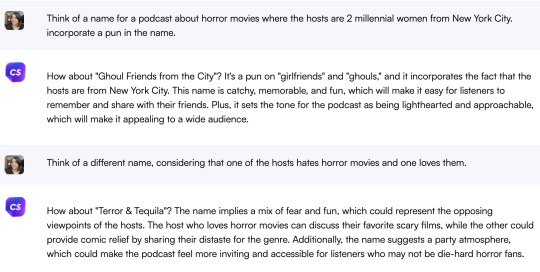
As we mentioned on the intro episode of the pod, we didn’t think “Ghoulfriends” was that bad! But there was a problem: we didn’t prompt it to output names of podcasts that don’t already exist. So, it didn’t tell us that there were already a number of podcasts with some variation of “Ghoulfriends” in their names. It also made a bunch of assumptions, for example - that we’re looking to come off as “lighthearted and fun.” Did it associate these descriptions with “women” or “millennials”? There might be data from its training that suggests that these groups want to be perceived this way. Or did it assume that these traits would be beneficial for any podcast, like “appealing to a wide audience”? This seemed to ignore part of the prompt that we did give it, that this was a podcast about horror movies, which implies a niche audience.
As for “Terror & Tequila” I have no idea where it was going. First of all, it sounds like a podcast about cocktail pairings for scary movies. Also, “…represent the opposing viewpoints of the hosts” suggests that if you hate horror movies, you must love… fun? Is comedy the opposite of horror? It’s clear that ChatSonic has never seen a horror movie. The last part is bizarro too: “the name suggests a party atmosphere.” Like, why?? Millennial women looooooove to party and do tequila shots. I gave it some generic feedback:
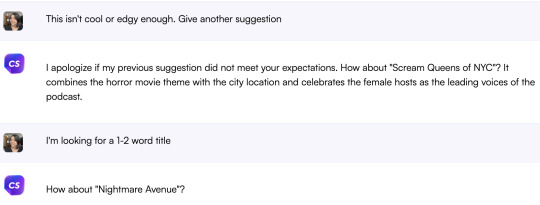
Not great output, and the explanations were shorter as my prompts got shorter. Also, sarcastic apology? It was all like “soooooo sorry my answers weren't cool enough for you” and called me a bitch, pretty much. Whatever! And “Nightmare Avenue” basically only considered the “horror” aspect and ignored all of the other details of each prompt. Lazy! I pointed this out:
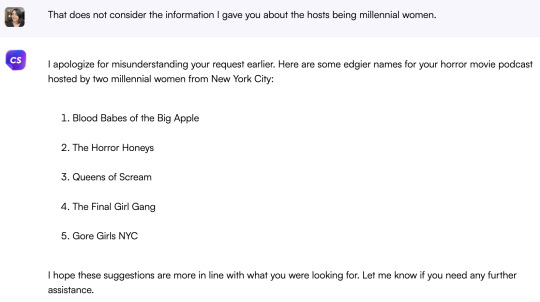
Less passive-aggressive apology, at least! Alot of millennial pop-culture “girly” tropes here, like calling each other “queen” and being in a “girl gang.” I’m least offended by “Horror Honeys” because maybe it thinks we’re sweet. “Blood Babes” sounds like it's probably some kind of sex kink or fetish. It sure loves alliteration too. We really fucked up by not going with “Blood Babe Final Gore Girl Gang of NYC,” honestly.
Ok, so, with ChatGPT I input longer, more detailed prompts for the most part:
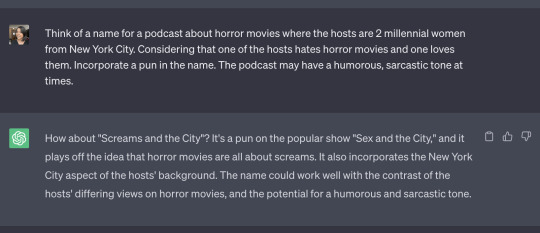
Ah yes, that’s what “Sex and the City” was missing! I’m glad it concluded that “horror movies are all about screams” - now we can stop our research and write a script where everyone screams at each other and then goes out for cosmos. As the kids say, it’s giving “humorous and sarcastic tone”. Maybe it needs more info? Let’s throw chaos into the mix and see what it thinks “sassy” means:
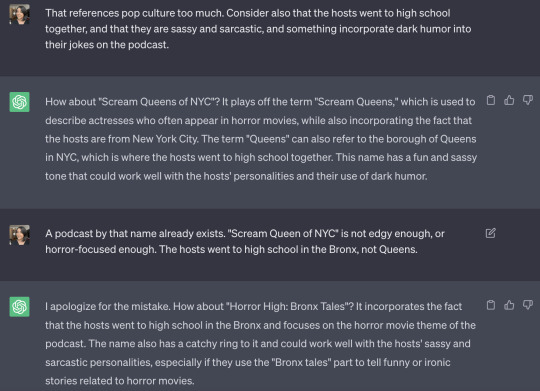
There you have it - they both came up with the same name. ChatSonic arrived at it from “cool or edgy”, ChatGPT from “sassy and sarcastic,” but they both got to "Scream Queens of NYC." I thought it was interesting that ChatGPT hallucinated that we went to high school in Queens - it responded so matter-of-factly! “Horror High: Bronx Tales” has a “catchy ring to it”?? Maybe we can use it for when we tell our inevitable “funny or ironic stories” on the pod.
I tried a few iterations where I gave it specific words to work with. For example, include "slice" in the name. But it was becoming increasingly evident that the pun aspect was the issue. Finally, I gave it this prompt for kicks:
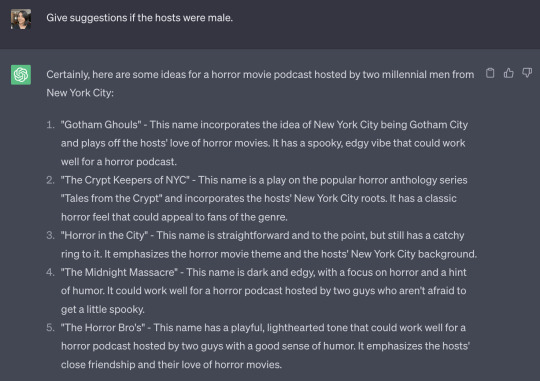
Umm, yes - I will now refer to men in NYC as “Gotham Ghouls”. “Midnight Massacre” might be a good name for, like, a metal band - adding that one to my Notes app. It's interesting how there's a gender association with that phrase, though, it seems neutral to me. Probably because men be massacre-ing IRL, I guess. “Horror in the City” sounds like a dating podcast, amirite.
Anyway, overall, I preferred using ChatGPT. It provided more relevant answers after refining prompts, better ”understood” descriptive words, and the free version seems pretty robust. ChatSonic seemed to have limited access to data (or different types of data), gave lazy answers at times, and isn't free to use for further experimentation.
Although we didn’t go with any of their suggestions, both were good brainstorming and ideation tools. From this exercise, we realized that most horror puns were mad corny. We also realized that the complexities of our POV and the overall vibe we were aiming for were challenging to articulate, and certainly too tough for either program to predict since it doesn’t already exist in their training data. This inspired us to get down to the bare bones (ha!) of what we’re trying to achieve with our podcast: figure out if something is mad scary or not. And voila - we had our name.
Also, again, a takeaway here is to be as specific as possible with prompting, or try giving it examples to get closer to what you’re looking for. Or, go completely opposite and try a prompt out-of-left-field to see if the results are interesting. I found it great for spitballing and getting our creative juices flowing. Just remember that it can’t generate anything entirely “new”, has no taste, and hasn’t gone through all the necessary childhood and lifetime trauma to be actually funny.
*HBR IdeaCast podcast: "How Generative AI Changes Productivity"
0 notes
Text
Mad Scary Pod - The Intro Episode Recap
Welcome to the Mad Scary Podcast! Hi. Hello.
In this introductory episode, we forget to share the podcast name, discuss what drew us to the horror genre, explain our relationship to writing (& each other), and ask ChatGPT to recommend horror movies to watch and discuss in future episodes.
We make a pledge that our podcasts will not be over an hour (let's see how we do). Millie (me) rambles on about why we chose the genre - spooky stuff being the sweet spot for 80s/90s kids. I name-drop Buffy the Vampire Slayer (both the movie and show) as well as the influence that movies like Scream (which Rina incorrectly attributed to Matthew Williamson instead of Kevin Williamson, our bad!) and The Ring had on my developing brain. Rina waxes nostalgic about writing 30-page papers and working production as part of the theater club (nerd alert) at our all-girls Catholic High School. We chat about our early creative collaborations (drop a Euphoria spoiler?) and talk about our general goals for this hella meta pod.
We delve in on our healthy curiosity of Generative AI from the POV of two millennial women, ex-teachers, women in tech, and brunettes with bangs that love Ratatouille. Also, is Ratatouille a horror movie? Maybe.
We make our case for Generative AI in the Arts which is: it's not going back in the box, so give it a test run and try to find the benefits of this new tool that is very much in its infancy. It can't be "creative" without us, and even when we prompt it to be so, it's pretty meh. Check out Rina's post for more on how she used text-to-image AI to help us create our logo. With that being said, there is some major potential for it to support creative thinking and endeavors. Also, let it help you negotiate a lower rent. Shout out Sean!
Finally, we ask ChatGPT in real-time to help us with a short list of movies to watch for our horror movie research. Check out our prompt and the OG list below:
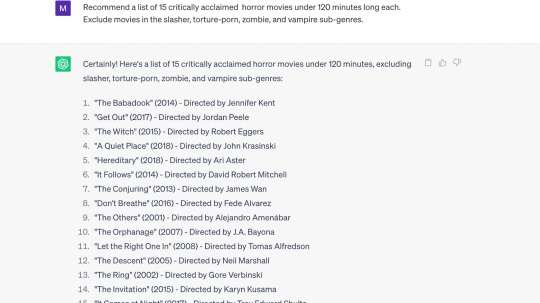
We got a pretty solid list - most of which are contemporary picks. We'll definitely need to make some adjustments. Also, umm, hello ChatGPT, Let the Right One In IS a vampire movie. Fix it!
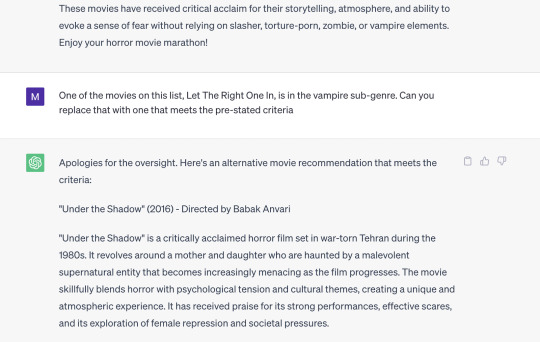
After a fairly insincere apology, ChatGPT redeems itself with a pretty good pick. We take this as kismet and decide this is the first movie we'll be reviewing for our next episode. "Under the Shadow" (2016), directed by Babak Anvari, is currently streaming on Netflix. Check out the trailer... if you dare!
So, yeah. That's what we said and did for the most part. Give it a listen if you haven't already. We'll be dropping our next episode in a few weeks!
#horror#ai#madscarypod#madscary#ratatouille#brunettebeauty#bronxborough#madscarypodcast#horrormovies#horrormoviepodcast#generativeai
0 notes
Text
Using text-to-image Generative AI to help create our Podcast Logo
When we decided to start this podcast back in April, Millie and I didn’t really know much about the process. Millie had been a guest on a podcast(link) in the past, and I have a couple of friends who run their own - that’s about it. What we did know was, a) that we wanted to spend a year researching and writing a horror screenplay, and b) we wanted to experiment with generative AI tools like ChatGPT to help us along the way. If you’re not sure what generative AI is, here’s a primer to get the gist of it.
We typed “how to start a podcast” into Google and hoped for the best. Aside from a device to record with, most results said that you just need 3 things to be able to publish your first episode: a name that represents you, an image or logo, and theme music. Our tired, screen-addled brains were grateful that we asked the AI overlords to help get us started.
So, how did these freaky internet bots help us create our Logo? Many AI text-to-image generators are free, or have some free functionality, while others (like OpenAI’s Dall-E) require you to purchase credits. I went with Picsart and DeepAI’s free tools, and Canva’s version that’s available with my existing paid subscription. Full disclosure, this was my first time using any of these programs so my first attempt at writing prompts for them was pretty weak.
Some of my starting prompts were super basic, like these:
Inside of a New York City subway car
Spooky New York City skyline
Full moon over the Brooklyn Bridge
To which I selected one of the available style choices (“Playful, “Filmic,” “Ink Printing”), yielding results like this:
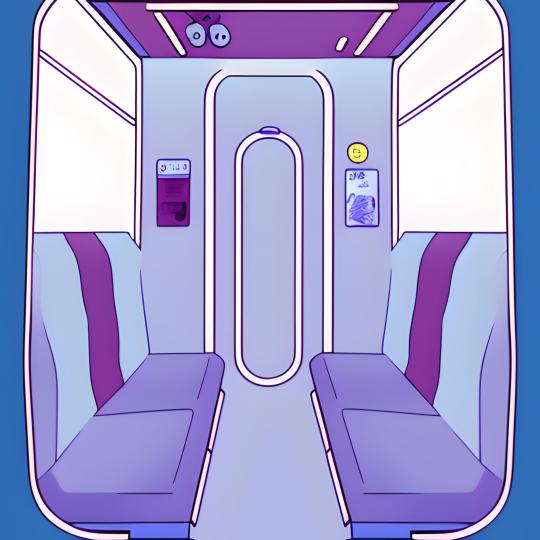
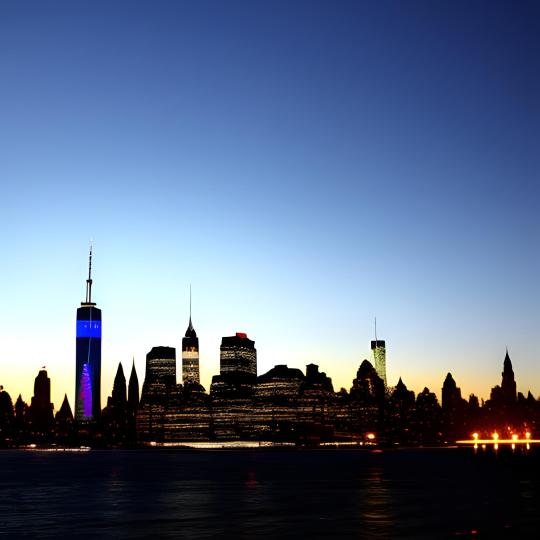
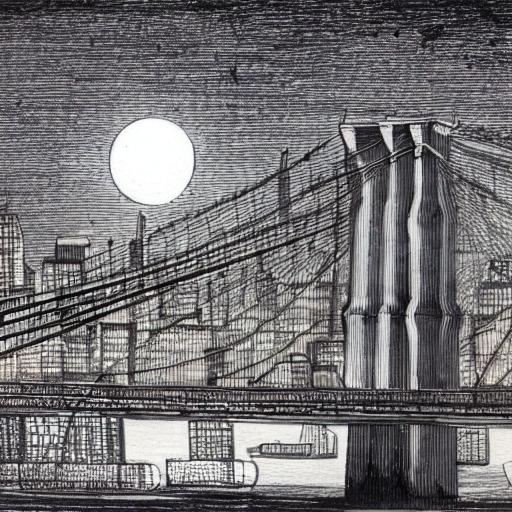
These weren’t really what I was looking for, so I started to refine them by adding info about the style, amount of detail, type of light, positioning, etc. For example:
“Full moon at night over the Brooklyn Bridge, centered, in the style of a children’s book illustration, spooky” (below, left) or “Inside of an empty dirty New York City subway car at night, realistic lighting, medium detail” (below, right):
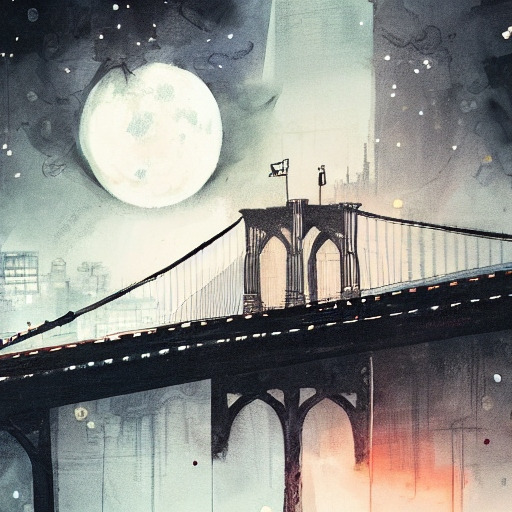
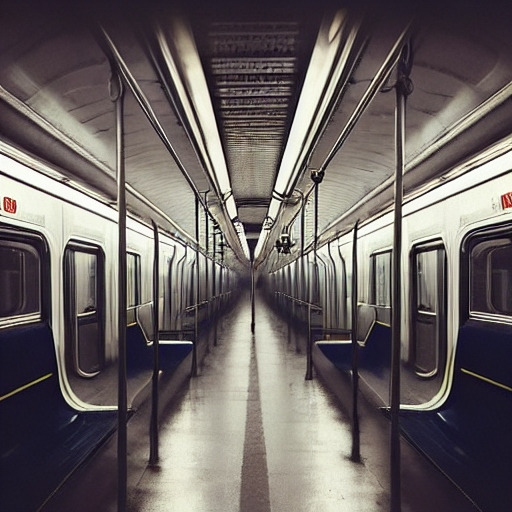
Most of these were warped or alien in some way. Like, any text you specified to be included came out as gibberish language, and anything to do with human - or, in our case, robot - forms were jacked up. Here are some of the robot rejects:

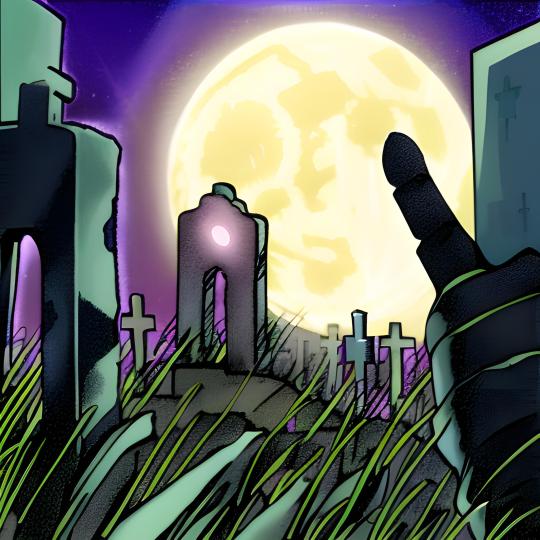
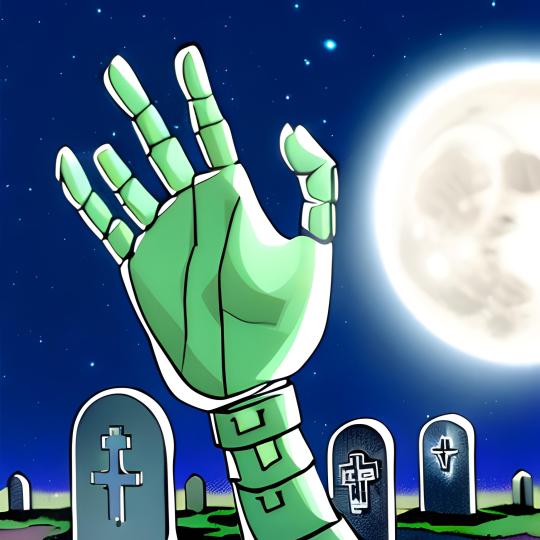
The prompt for both was: “one metal robot hand reaching up out of the dirt in a cemetery at night during a full moon, centered, high detail, realistic lighting.” As you can see, there’s a lot of weird stuff going on here. Extra fingers, half finger, half hand, hand off-center, moon off-center, tiny moon, weird double-crosses on graves - and that’s with some pretty specific prompting!
Canva’s tool was easiest to use because I could refine the prompt quickly after each batch was generated, and see the change until I got something that I liked that was usable. I think the prompt for these two was something like, “Inside of a spooky New York City subway train car in the style of a retro anime” and “New York City subway train car passing by in the style of a comic book”:


I messed with the colors, saturation, filters, and some lil ghost buddies. Then layered the text, added various effects to the fonts, etc until they looked like this:
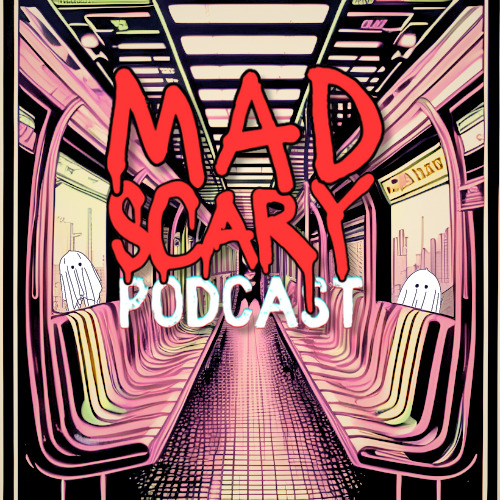
There are still some things I’d want to change about it, and it’s obviously derivative of the base “Retro Anime” style it was pulling from. But the point was to try and do some things that were out of our element with the help of generative AI and I think this was a good example of collaboration. Here’s one of the robot ones that also came out alright:
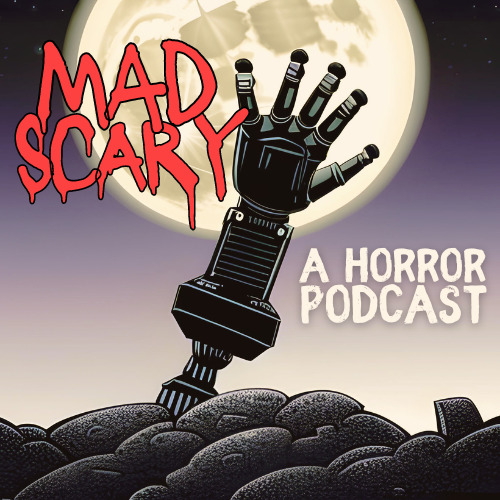
Honestly, this took a LOT of time to prompt and re-prompt, select, and edit. Likely way more time and effort than it would have taken a professional Graphic Designer to ideate concepts, get approval, and do edits for something like this.
Some takeaways:
Text-to-AI generators are fun and easy to use, but yield better results with detailed prompts
The generated images are, by design, derivative of other human artist creations in some way
A great way to get inspiration, or develop a raw concept
You can make the output yours with lots of editing and a human touch
Is not a replacement for the quality and originality you’d get from a real life Graphic Designer, or any other visual artist
#madscarypodcast#madscarypod#madscary#artificial intelligence#horrormoviepodcast#generativeai#text to image
0 notes
Text
Mad Scary Intro
Hi!
Welcome to Mad Scary Podcast, a year-long podcast experiment and research project documenting our first-time horror movie screenwriting process. On the pod, we dig into movies that explore scary themes and tropes that we love as inspo for an eventual script. To make matters worse, we're throwing in a heathy curiosity for and discussion of the current moment of Generative AI, from the POV of two millennial women (Rina & Millie), ex-teachers, and best friends from the Bronx.
Our intro episode is out -- learn a bit about us, what we're working on, why we're doing this, and how we intend to use Generative AI systems (like ChatGPT) to help us along the way.
We'll be using this blog as a companion to the podcast to document anything from episode recaps, to references, to digging in on a specific topic or horror trope.
Thanks for reading!
#madscarypodcast#madscarypod#madscary#horrormovies#horrormoviepodcast#scarymovies#scary moviepodcast#scarymoviepodcast#screenwritingpodcast#generativeai
1 note
·
View note